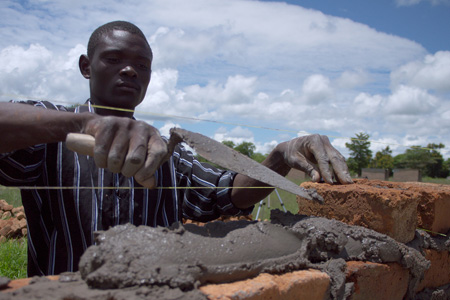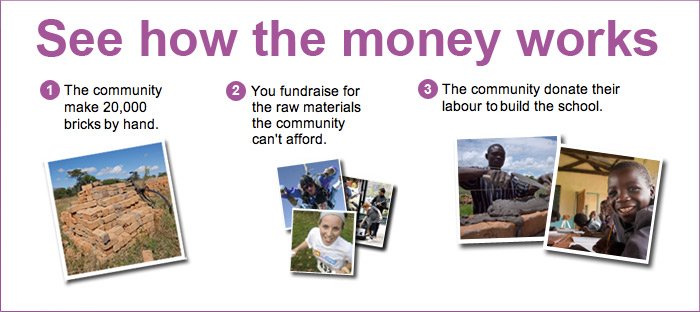If you make a donation to LearnAsOne, what does your money actually buy?

The communities happily donate their time to make bricks and construct their school.
Bricks, cement, roofing sheets, windows, doors. These are the main raw materials you need to build a school.
You can make bricks by hand. You need to recover loose soil from anthills, place it into a rough wooden frame, mix with water, compact it, then leave the mud blocks in the sun to dry.
When there are enough bricks, you stack them over a large fire for three days to harden them off. It’s hard work, but it can be done. So the community do it. Enough times for 20,000 bricks per classroom in fact.
What they can’t bring to the party
But the community can’t make cement from local raw materials. The same goes for glass and roofing sheets, or the iron bars which are needed for a safe room to store exam papers in. They need to be bought in, and they are prohibitively expensive for most rural communities in Africa, but are absolutely essential for a modern education.
That’s where your money comes in.
In total the raw materials cost £6,500 per classroom. It’s the same amount for a small teachers’ house. In Zambia, once you provide a classroom, a teachers’ house and a clean water supply the government will usually provide a trained teacher for free.
Schools have other requirements too, such as a sanitation block and a borehole as alluded to above. The costs are different but the process is very much the same. The community contributes whatever it can for free and your money buys in what they can’t afford.
We let you know the exact costs on a project-by-project basis.
Building the school
Having already made thousands of bricks by hand the community are clearly not afraid of hard work. And with a school being vitally important to developing the community they are more than happy to donate skilled and unskilled labour to build it too.
Before construction begins a qualified builder from the community has to be approved by a building officer from the Ministry of Education. They have to demonstrate their skills and agree to build the school to government specifications.
Once these checks are carried out our partner buys the raw materials and delivers them to school. The community sign a contract agreeing to build the classroom or teachers’ house within six months. If they don’t then we are allowed to take the raw materials and give them to another community. To date, this has never been necessary.
See the money in action
We strongly believe that if you are kind enough to donate or fundraise for a school then you should be able to see how your money is spent. So we always ask one of the community members, often a teacher, to write a regular diary to update you the progress being made and the positive change your generosity is enabling.
We also share other stories, photos and videos so you can get to know the community a little. And we encourage you to ask members of the community questions through commenting on the blog too.
Simakakata Community School in Zambia is the first community we’ve had the pleasure to work with. There are already over 50 updates on the school blog which you can read at your leisure.
Updates in your inbox | Sign up for our e-newsletter
But the simplest way to see how your money works is to sign up for our e-newsletter. You’ll get to read stories from the schools, the latest news from around the LearnAsOne community and information about how you can help to fundraise.
To sign up just enter your email address below.



